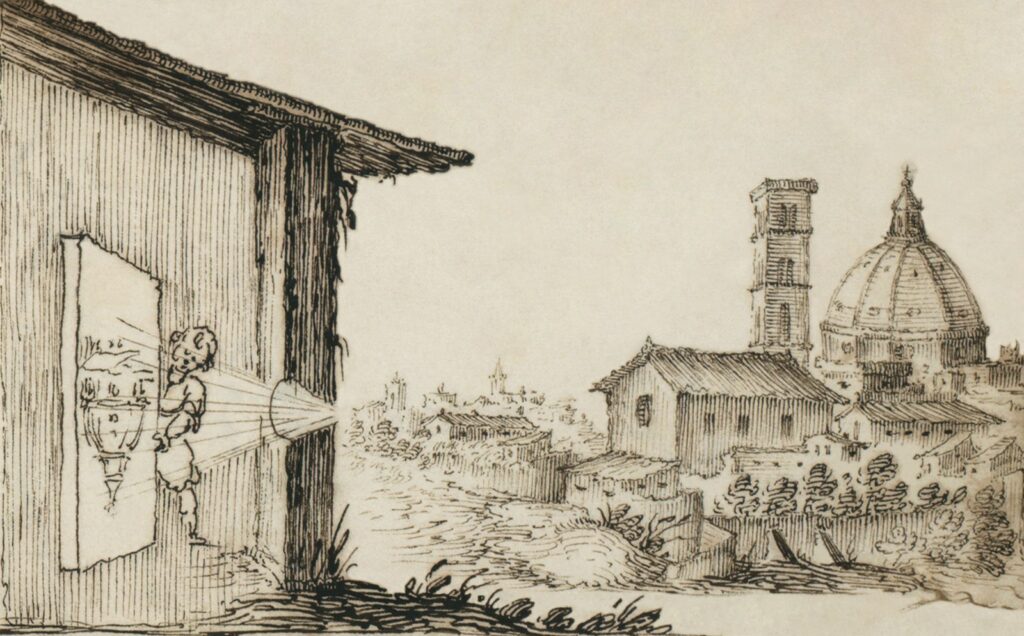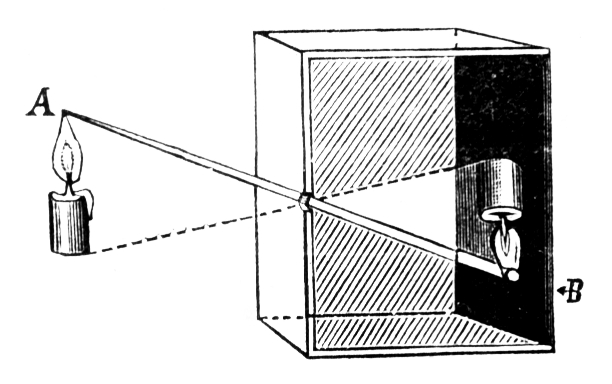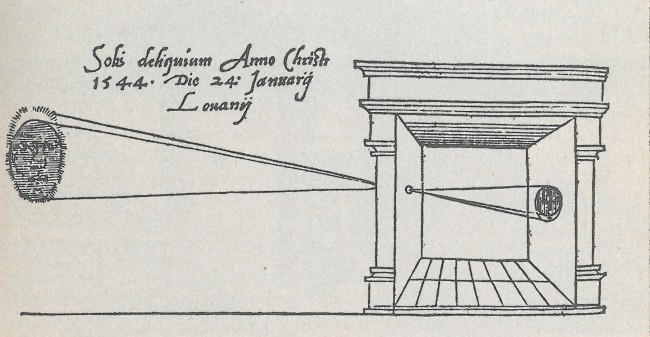Light has always fascinated humanity, especially how it can be manipulated to produce illusions and pictures. Long before film or digital cameras, there was a much simpler way to reproduce an image, albeit only with light–the camera obscura.
This optical device, which means “dark chamber” in Latin, has been around for centuries, dating back to China in 470 BC. But did you know that there is evidence that the camera obscura could be even older than that?
From cave drawings in prehistoric times to ancient Chinese sundials, camera obscuras have been around in some form for a long time. Let’s delve into the history of these pinhole cameras and see just how big of a role they played in the creation of modern photography.

What is a Camera Obscura?
In order to understand the history of the camera obscura, first you need to know what exactly it is!
A camera obscura can be either a dark room or a box with a small hole that lets light in. When the light outside enters the small hole, it creates an image on the outside wall of the room or inside of the box.
But how does all of this happen?
- Light, usually sunlight, enters through a small hole, or aperture, in the darkened room or box.
- The light travels in a straight line and once it comes through the aperture, it projects an upside-down and reversed image of the scene outside onto the opposite wall or back of the box across from the hole. The image is inverted like this because of the small size of the aperture, which bends the light in such a way that it inverts.
- The projected image can vary in size and brightness depending on the size of the aperture hole and the distance between the aperture and the surface the image is being projected on.

History of the Camera Obscura Timeline
Early Uses of the Camera Obscura
The camera obscura has a long and fascinating history. While there is no concrete evidence of camera obscuras being used prior to 470 BC, there are some theories that the practice may have had a role in creating paleolithic cave paintings.
An early text that might describe the use of a camera obscura-type device can be found in the Chinese Zhoubi Suanjing writings. These were created between 1048 BC and 256 BC.
These texts described a sundial-like object called a gnomon that had holes drilled into it. Through these holes, a pinhole image of the sun would be projected on the ground–just like a camera obscura.
5th Century BCE to 3rd Century BCE
With the previous examples, experts can only guess that camera obscuras were being used. By the 5th century BCE, the records of camera obscura use started to be more detailed. These descriptions give us the first firm examples of the camera obscura.
Our earliest record is from a Chinese text called Mozi, named after the author of said text, who was also called Mozi. Mozi described how an image is displayed inverted by a “collecting point”, which we can assume is the aperture that collects the outside light.
The next mention of the camera obscura comes from none other than Aristotle. One of the uses for the camera obscura, besides projecting pictures, is viewing solar eclipses safely.
The camera obscura will project the eclipse on the ground where it can be safely observed. Aristotle wrote about his eclipse observations, describing pinhole projections, hinting at his use of a camera obscura.
11th Century CE to 17th Century CE
In the 11th century, an Arab scholar called Ibn al-Haytham contributed a large amount of information to the study of the camera obscura. Ibn al-Haytham studied solar eclipses and the use of the camera obscura to observe them.
Later, he would write the Book of Optics. In it, he went into detail regarding how light would travel in straight lines, and how the same light would become warped when passing through an aperture.
English philosopher Francis Bacon would also spend time studying the science behind the camera obscura projections. One of the first diagrams of the camera is attributed to Bacon. However, some believe that it was another scientist who created the drawing.
One of the most impactful individuals to spend time on the camera obscura was Leonardo da Vinci. Da Vinci is famous for his innate ability to combine science and art in beautiful, unexpected ways. His study of the camera obscura was no exception.
Da Vinci was inspired by the work of Ibn al-Haytham. He drew 270 diagrams of the camera over his lifetime.
He also provided us with one of the clearest and most concise descriptions of the camera obscura. This gave us a valuable glimpse into the understanding of light and optics in the 16th century.
By the 17th century, portable camera obscuras were being made. They were used by artists to capture picture-perfect scenes that would then be traced onto paper or canvas.
This was made possible with mirrors. The mirrors would reflect the projection directly where the artist desired it.
In the same century, astronomer Johannes Kepler was the first person to coin the term ‘camera obscura’. He used the device to study the sun and planets, even documenting sunspots with it.

18th Century and Beyond
By the 18th century, portable camera obscuras with intricate mirror systems inside had all but replaced the huge, room-sized camera obscuras of the past.
They became increasingly popular with artists. Some speculate that 17th-century master painter Johannes Vermeer used one to capture the intricate details of his paintings.
The camera obscura reached its pinnacle in 1826, when Joseph Nicéphore Niépce invented a technique called heliography. Heliography uses light-sensitive chemicals on a metal plate.
When the projection from the camera obscura hits the plate, the image is permanently captured on it. The process took a staggering eight hours.
However, once it was done, Niépce had the world’s very first photograph. It was dubbed View from the Window at Le Gras.

Niépce, his son, and other photography superstar Jacques-Mandé Daguerre would go on to invent the daguerreotype. These daguerreotype images could be produced in minutes instead of hours, using the camera obscura and silver-iodine plates exposed to mercury fumes.
Later, in 1839, the French government would purchase the daguerreotype technique from the men. It would become publicly available soon after.
For the first time, real photography was available to the masses. Daguerreotypes played a pivotal part in photography becoming an art form.
Soon enough, camera obscuras would be replaced by other types of camera–film, and then much later, digital. But none of them would exist without the camera obscura.
Camera Obscuras in the Modern Age
Despite being considered completely outdated at this point, camera obscuras still have some uses that keep them more relevant than other pieces of antique technology.
One major use for a camera obscura comes around each time we have a partial or full solar eclipse. Since it’s dangerous to look at the sun, even in an eclipse, scientists are always looking for ways to safely observe the phenomenon.
One of the first examples of these safe eclipse observance devices is the camera obscura. It’s still used for this now!
When viewing a solar eclipse with a camera obscura, the eclipse will be projected onto the ground. There, it can be watched in real-time.
Interestingly enough, this can happen naturally when the sunlight during the eclipse comes through natural openings like holes in tree leaves. It projects dozens of eclipse images onto the ground below.
Another popular use for the camera obscura is for school projects. This is because the camera obscura is so simple to construct that it can be made right at home! Here are the instructions for creating your very own camera obscura:
- Find a dark room or area.
- Build your camera. You will need,
- A box
- Scissors
- Tape
- Heavy paper
- A small nail or pin
- Cut the paper to fit inside one side of the box and use tape to attach it–this will be the screen.
- Make two holes in the side of the box opposite of the paper, one small and one large enough to see through. They should be far enough apart that that small hole won’t be blocked by your head when you’re looking through the larger hole.
- Close and tape the box
- Point your camera holes towards something bright like a window, and look through the larger viewing hole. On the paper screen, you will see the image of the bright subject projected!
- Try to aim at something easy to see with a strong silhouette, like a tree or house. The brighter the light and the more solid the subject, the clearer the picture will be.
Making your own camera obscura is more than just a fun project. It’s a way to connect with an amazing piece of photography history.
When you look through a camera obscura, you’re seeing the same images that great minds like Aristotle and Leonardo da Vinci did all those years ago.
References
“What is a Camera Obscura?”
https://www.camera-obscura.co.uk/article/what-is-a-camera-obscura
“What You Don’t Know About the World’s Oldest Photograph”-Megan Robinson
https://www.artandobject.com/news/what-you-might-not-know-about-worlds-oldest-photograph